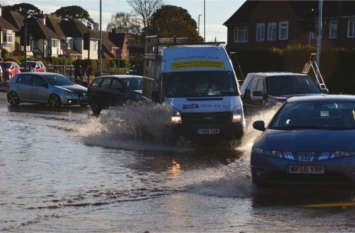There is no escaping transformation and innovation in a sector that continues to grasp new priorities as it fights added pressures. We wrestle with myriad trips and modes that traverse our complex settlements.
The leadership we provide in managing pressures is on a scale far removed from when Romans first chose a point to ford the Thames. Yet 2,000 years later the nexus that is London, and the international powerhouse of Heathrow, prove that economies still thrive at crossroads.
Having worked across air, rail, ports, buses and roads, I know there is a lot of inward thinking that is vital for operational excellence, and the concomitant attention to detail provides the daily service our customers expect. Silos however also create tunnel vision, skewed priorities, and frustration from sector specialists.

John Lamb
Look at road safety. Every loss of life or injury is truly dreadful and there should be safer vehicles and more driver education. However, there is now the wider issue of the silent killer of air pollution, which robs youngsters of a decent quality of life through asthma and reduces all our life expectancy by an average eight months.
Transport professionals have embraced reconnecting with public health as a council function but so many of the pressures on health care from air pollution, road safety, trips and slips are avoidable.
At Hertfordshire CC I helped lead TravelWise, but 25 years on and cycling and walking are marginal at best in terms of reducing the billions the NHS spends on obesity.
Access to opportunity
From walking to the local primary to catching the bus to secondary school, transport is the gateway to learning. Conversely, a lack of transport is a barrier to later learning and jobs.
As Stansted’s senior planner, I found untapped talent in north east London, so working with bus and rail operators, I tweaked services and simplified fares with a simple ‘Airports Travelcard’.
From the initial handful, thousands now support airport growth and take wages back into communities that were previously isolated. That first cohort of staff made an indelible impression that training and raising people’s sights can create a new paradigm.
The economy and demand for travel are inextricable. But local bus and better rail are still Cinderella services – there is more talk about potholes than the decrepit average fleet. I see lots of vision and strategy but delivery remains slow.
Edinburgh’s Borders Railway has proved that ‘if we build it they will come’, but I contrast that with the untapped potential. After the Heathrow Express tunnel collapse we built a station off the Great Western Mainline in nine months – new stations such as Elland, West Yorkshire should be no-brainers.
Aligning skills/expertise to customer need and member priorities
Austerity has sapped the training budgets and prevented many staff from understanding the latest developments and innovations. Managers fail to gain from best practice offered by the Association of Directors of Environment, Economy, Planning and Transport, the Technical Advisers Group, the Institution of Civil Engineers or conferences such as Traffex and Cold Comfort.
Adoption of ‘no-brainer’ solutions such as LEDs, handhelds, fleet tracking, and Big Data are delayed. Instead I want teams equipped with the new thinking that is metadata, bluetooth and embracing Department for Transport (DfT) funded trials of automated scanning that will shed new light on age-old issues.
On the other hand, it does not take a Sherlock to understand that 75% of all potholes occur between Christmas and Easter – so why have gangs fixing them six months later?
Invariably getting closer to the customer is a win/win. Low cost carriers grew their model by being close to customers. Even large counties can get closer to customers than modest sized districts by careful organisational design and a clear line of sight into locally accountable teams.
Using front line insight is crucial. At Stansted it was the drivers who knew the location, nature and cause of delay and gave me insight to rebut prevailing wisdom. I side-stepped £250m of supposed ‘essential’ rail works.
Data, technology and accountability
Equipping front line teams with modern systems is essential to optimise their efficiency. It is amazing that councils have millions of pounds of plant and staff that are not aligned. Council ‘parks’ or ‘cleansing’ teams still operate in their own costly silos.
This is hardly ‘transformation’ and many staff relish the chance for basic ‘task and finish’ – if empowered.
Big Data can help but handhelds are still not universal and when in place are often under-utilised. I cannot do justice here to Big Data but volume of data always beats less frequent but sharper systems; a single weather station always loses out to a thousand cheap gauges.
Band 3 councils in the self-assessment process should be ready to explain to the DfT where each collapsed light column was in a renewal programme. Asset management is more than blacktop and potholes and councils should define their journey to 100% LED and revenue savings that flow from this.
If we see ‘special measures’ in schools, children’s services and hospitals, where are our criteria to assess failure? It is inconceivable that all 153 highways authorities are uniformly top performing. Political geography never considered the optimum scale for certain functions or journey-to-work areas that might facilitate bluetooth corridors and smart signals.
There needs to be more robust data to create transparency. One potential solution is to have specialist automated high frequency scanning of networks – agnostic of boundaries.
Funding
The DfT continues to set a clear and positive direction of travel on funding, but a new model must evolve within asset management planning that is about treasury management, prudential borrowing and Whole of Government Accounts.
Asset management planning should demystify and enlighten Whole of Government Accounts. Underpinning this must be a clear understanding of the asset baseline and deterioration models that can be dynamically informed – monthly by smart sensors.
Combined with this, we must change the narrative and show people the wider social costs of our failing assets. The DfT could help by contrasting a challenge fund that helps a handful of councils win big with a raft of local authorities who might be nudged over target hurdle rates for LED refits or leveraging future highway works.
Procurement and Commissioning
The concept of a 10-year model of perhaps 36-48 months of frontloaded investment followed by a gilt edged warranty demands skills that are rarely seen. I know half a dozen councils who would relish this approach and they could be trailblazers. However, there is not a uniformly high enough quality in contract management and procurement. This is the difference between procuring pens versus multi-year contracts or a bypass.

Follow the leader on floods?
Equally, there should be more honesty on contracts cancelled early or where there was failure. I was impressed by Balfour Beatty’s article in Surveyor last year as to how they are changing their approach and culture. Might Veolia do the same for the failed Sheffield 35-year waste contract, finished after ‘just’ 16 years in?
Many councils still defer to the contract they went to market with 10 years ago. No council should procure without saying why the Highways Maintenance Efficiency Programme suite is not suitable, so ‘comply or explain’ should be the motto – quirky features and parochial specifications cost money.
New certification to oversee procurement might add credibility that could protect millions over a contract’s life. Equally sharing a neighbour’s contract should be far easier.
Resilience
Having witnessed Storm Eva first-hand on Boxing Day 2015, I would be remiss to not mention resilience. This winter has been slightly less wild but Storm Angus and recent high tide flooding alerts for Lincolnshire, Norfolk, and Essex were unpleasant reminders.
Unless a council has been recently visited by nature’s wrath, senior staff should be encouraged to shadow those councils who are in the thick of it; it might even develop into some form of mutual aid or twinning arrangement.
The National Resilience Review was largely about government departments but local government must look hard at how we work collectively and respond.
The DfT invested in national salt stocks but we rely on a few depots held by the Environment Agency for a few hundred metres of flood barrier. Instead we need regional centres (logically in fast responding river communities) that can be readily deployed – agnostic of boundaries. The public probably think we already do this.
Calderdale’s recent purchase of cutting edge weather forecasts and prediction systems provides pinpoint accuracy as to when and where to deploy, but other councils cross their fingers.
Cumbria has a couple of Mercedes-Benz Unimogs, which ensures they can provide a service even when fire and rescue are stranded – it will only be a matter of time before the midwife is whisked through flood waters, but what excellent insight by Cumbria Highways.
As I continue to advise councils and service providers on ways to improve, I find that new data, case studies and industry best practice grows my scope to support councils. Ideally transformation is part of the day job but often an ‘agent provocateur’ is essential to break through artificial ceilings, create a new paradigm and establish a new narrative.
John Lamb is junior vice president of the Local Government Technical Advisers Group
Register now for full access
Register just once to get unrestricted, real-time coverage of the issues and challenges facing UK transport and highways engineers.
Full website content includes the latest news, exclusive commentary from leading industry figures and detailed topical analysis of the highways, transportation, environment and place-shaping sectors.
Use the link below to register your details for full, free access.
Already a registered? Login